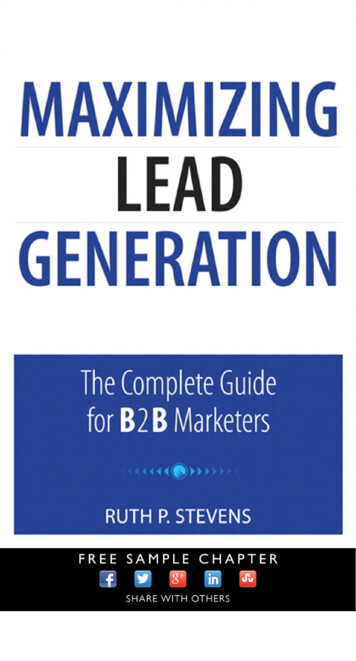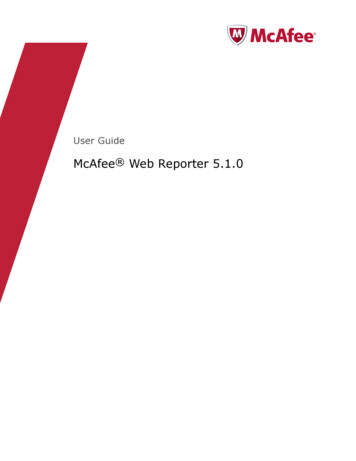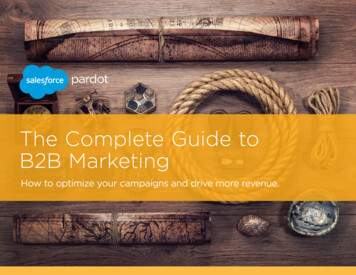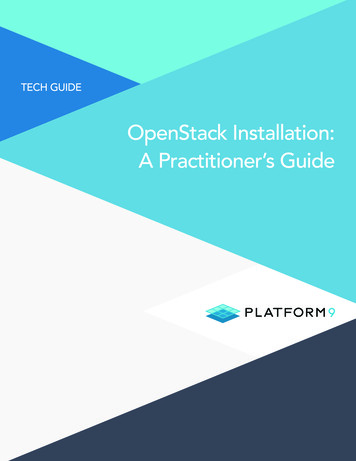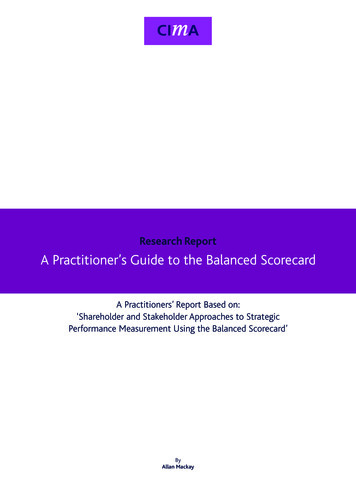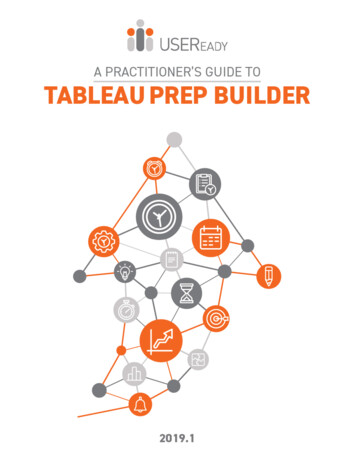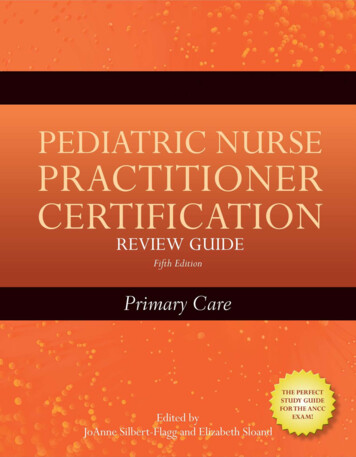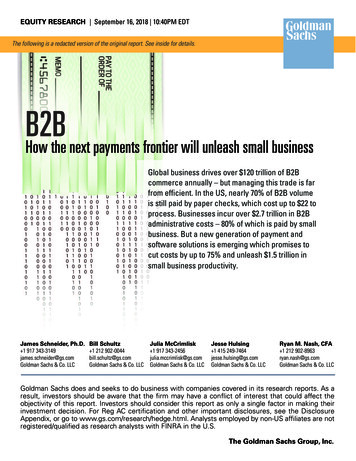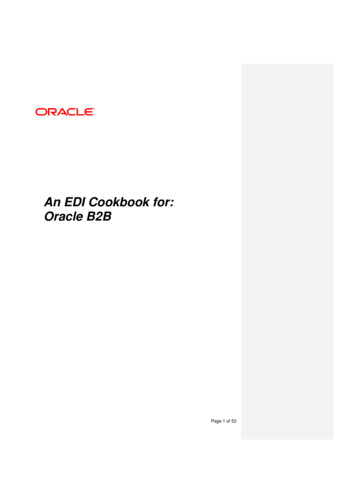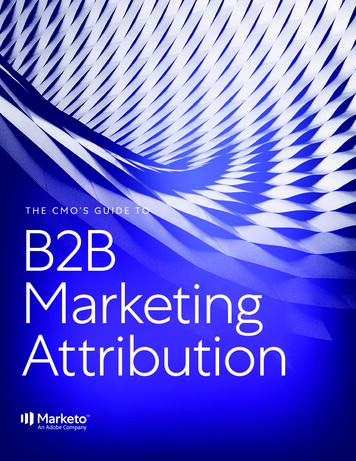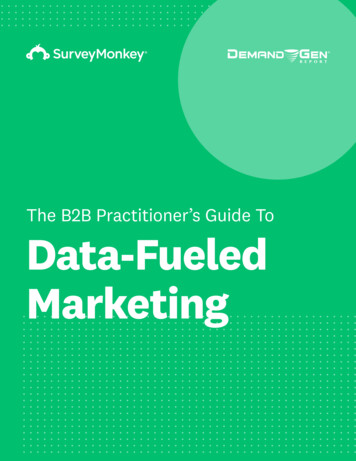
Transcription
The B2B Practitioner’s Guide ToData-FueledMarketing
For successful B2B organizations, keeping a pulse on customers’ changingneeds is critical. In today’s digital environment, 87% of customer experience(CX) professionals say customer feedback is more important than ever.Gathering and acting on feedback throughout the customer journey can helpB2B organizations: Stay in touch with what is happening in their customers’ worlds; Uncover new market opportunities and drive business decisions; Guide content marketing initiatives to develop campaigns that resonate withcustomers; and Support customer success initiatives and enhance CX.“Leveraging feedback at all stages of marketing can be a competitivedifferentiator and can play a role in shaping your entire marketing strategy,”said Jack Foster, Sr. Director of Demand Generation and Marketing Operationsat SurveyMonkey. In fact, 52% of companies that collected customer feedbackchanged their business strategy based on what they learned, versus only 30% ofcompanies that did not.This guide will share practical tips to helpB2B practitioners fuel data-driven marketing,sales, and customer success initiatives throughgathering feedback and assessments.The B2B Practitioner’s Guide To Data-Fueled Marketing2
Developing A Natural Dialogue With CustomersFeedback from your customers, prospects, and the market can uncovernew opportunities and offer data to inform business decisions. In 2020,60% of organizations added new touchpoints to listen to customers innew places. With so many opportunities to gather customer feedback,where should you start? Leela Srinivasan, Chief MarketingOfficer at SurveyMonkey, suggested these best practices:Review What You Already KnowBegin by auditing the data your organization already has, how and where you collected it, andwhere you stored it, Srinivasan advised. “Take stock of what you know and what you have.”Pinpoint What You NeedCreate a consensus about the type of feedback you want to collect and why. Focus on areas inyour business you are looking to measure over time, whether that’s customer satisfaction, newproduct/feature adoption, or exploring your customers’ changing needs.The B2B Practitioner’s Guide To Data-Fueled Marketing3
Decide When To Request FeedbackIdentify the customer touch points that offer an opportunity to gather the kind of feedback youseek. Collecting feedback, such as Net Promoter Score (NPS), on an ongoing basis can helpmeasure longer-range impressions, Srinivasan said. Other common touch points or milestonesfor requesting feedback include: After a customer service interaction After closing a sale After a purchase After losing a sale After implementationDetermine Whom To Ask For FeedbackExpanding beyond existing customers to get feedback from prospects or the public yieldsvaluable market research that guides brand and product development and provides acompetitive advantage. However, fewer than one-third of organizations collect such feedback.Feedback Spotlight: Market Research InsightsDaniel Scharff, Head of Insights and Analytics at JUST, a food startupoffering plant-based egg alternatives, relies on surveys to gather a wide rangeof market research. He uses SurveyMonkey Audience to conduct DIY marketresearch and sends over 40 surveys annually. Questions are sent to a variety ofsegmented audiences and high-quality results can be collected within minutes.The end-to-end market insights gained from SurveyMonkey have informedJUST’s product development, marketing messages, global expansion, and more.The B2B Practitioner’s Guide To Data-Fueled Marketing4
Design Your Survey“Start with the end in mind,” said Srinivasan. “Know what you’re trying to prove or disprove andask questions that will elicit the information you need.” Tips to keep in mind include: Tailor it to the customer journey — Whether it’s in-store kiosks, SMS polls, or technologythat gently surfaces on your website or in your app, look for the least intrusive way tocollect data. Engage the customer — Keeping questions short and sweet will garner you moreresponses; a relaxed, informal tone makes responding feel less like a chore and more like aconversation. Balance qualitative and quantitative questions — “There’s power in the quantitative, butthe qualitative often has more [emotional] impact for the audience,” explained Srinivasan. Look for the “why” — Dig for reasons behind customers’ responses. “Companies oftenmiss the mark here,” noted Srinivasan. “Understand the why through the customer lens soyou can continuously improve how you are showing up, adding value, and engaging yourcustomers.” Test and re-test — Run internal tests to get input on the questionnaire design to makesure it works properly.Use Trusted Sources And Domains To Gather FeedbackSeeking feedback beyond your existing customers and social media followers can providevaluable insights to drive business growth. However, when reaching out to a wider audience, it’simportant that those responses are trustworthy. Using an experienced provider to field yoursurvey can expand your reach while ensuring respondents are qualified.“Working with reputable third-party software can increase both your response rates and thequality of responses,” noted Srinivasan. For example, TechValidate by SurveyMonkey cangather customer testimonials and proof points while providing the validation of a third party.The B2B Practitioner’s Guide To Data-Fueled Marketing5
Choose Technology That Can Give You A Leg UpAs companies increasingly rely on customer feedback to drive marketing decisions, gatheringinput quickly is essential to responding nimbly. The right technology can help you designbetter questions so you can efficiently glean critical information from respondents. Combiningartificial intelligence (AI), machine learning, and data from 21 years of conducting surveys,SurveyMonkey Genius can make suggestions to automatically help optimize survey design.Gathering data is only the first step — you need to analyze the responses before you can acton what you learn. Technology incorporating AI can facilitate rapid analysis of text responses,giving your business a competitive edge in understanding customer sentiments. Using machinelearning and natural language processing (NLP), SurveyMonkey Sentiment Analysis can drawquantitative insights from qualitative data such as text responses.Incorporate Data Into Systems Of RecordTo get the most value from customer feedback data, look for a solution that lets youintegrate results with the tools your team already uses. Integration with your CRM, marketingautomation, collaboration, and analytics apps enables faster decision-making and quickactions to benefit from your findings. For example, SurveyMonkey integrates with a wide rangeof popular marketing business apps, such as Salesforce, Tableau, Hubspot, and Marketo, sousers can use their existing tools to glean additional insights from customer data.Take Action“The whole point of gathering feedback is to close the loop and act on what you learn,” saidSrinivasan. “Get in front of executives with the ‘so what?’ of the data and an action plan toimprove customer experience based on what you’ve learned, plus the metrics that will move itfrom a business standpoint.”The B2B Practitioner’s Guide To Data-Fueled Marketing6
Leveraging Feedback To Fuel Content Marketing InitiativesAlthough 61% of B2B marketers said content marketing is one of theirmost important marketing tactics for the next 12 to 18 months, 43% notedlack of meaningful content is a significant challenge.Data gathered from customers can power effective marketing content. Three-fourths (75%)of people think content containing data is more trustworthy than content without data, while73% said it’s more persuasive. Marketing professionals also overwhelmingly prefer the idea ofincluding more hard data in content, with 98% wishing they had more data-fueled content.Collecting customer feedback can help marketers fill gaps in their existing content marketingstrategies. “The most powerful voice in marketing is your own customer’s voice,” Srinivasanpointed out. Sharing customers’ praise for your product or service is potent persuasion.The B2B Practitioner’s Guide To Data-Fueled Marketing7
Survey data backing a topic your audience is interested in and relevant to your brand willuncover data you can use in content to: Build brand awareness: Unique, original data is attractive to the media. Share findingswith reporters, partners, and other brands to attract media coverage and raise yourbrand’s profile. Get leads: If your data is valuable enough to your audience, prospects will share theircontact information to get it. Data-based gated content such as white papers or webinarscan generate leads while providing value. Drive organic traffic: Create SEO-optimized articles or blog posts based on your data andlink to them from social media and other pertinent sites.Maximize results from your customer data by repurposing content in a variety of formats.“The results of one survey can be used in multiple channels — blogs, articles, white papers,infographics, webinars, presentations,” said Srinivasan. “There’s really no limit.”It takes time, coordination, and lots of approvals to analyze survey data and turn the insightsinto useful content. “That’s a heavy lift, especially for smaller teams,” Srinivasan noted. Theright software can help. For example, TechValidate by SurveyMonkey automates a collection ofcase studies, testimonials, and other content.Feedback Spotlight: Creating Content That ResonatesData has always been key to supporting the marketing message at financialservices company Brex. When Aliza Edelstein, Director of Brex’s Product,Partner & Content Marketing team, was tapped to speak at a trade show, shegathered feedback to develop her presentation using SurveyMonkey Audience.In just two days, Edelstein collected both qualitative and quantitative feedbackthat helped pinpoint her customers’ challenges and create a value propositionthat would resonate with the audience of financial decision-makers. The insightsshe gathered became part of a research report that Brex distributed to the tradeshow audience and promoted online and in social channels before the show,boosting interest and demonstrating thought leadership.The B2B Practitioner’s Guide To Data-Fueled Marketing8
Acting On Customer Data Insights For Sales EnablementA whopping 82% of people trust their peers’ opinions morethan brand or product copy. No wonder sales teams arealways looking for customer stories and hard proof points tohelp win new deals, noted Srinivasan. “Prospects buy basedon emotion with data points to back it up,” she said.Customer feedback can provide the insights marketingteams need to better align with sales and cater to prospectsand customers. “Using customer surveys to gathertestimonials, proof points and case studies and providingthe sales team with easy access to those assets helps themaccelerate progress and close more deals,” said Srinivasan.To collect the data you need, she suggests to:Capture Customer Sentiment At ScaleThe more responses you gather and the greater variety of customers you get feedbackfrom, the better. Insights into the opinions of customers in specific verticals, personas, andcompany sizes is key to developing relevant content and persona-targeted messaging for yourcustomer base.Gathering data for each segment of your target market can be daunting. A third-party servicesoftware like TechValidate can streamline the process by collecting responses at scale, thenfiltering and analyzing them to deliver usable data.The B2B Practitioner’s Guide To Data-Fueled Marketing9
Find Out Why Sales Were Won Or LostAsk customers about needs, challenges, timelines, and other concerns around the purchasingdecision. Srinivasan recommends soliciting feedback from customers after each sale is madeor lost and sharing the data internally with sales and cross-functional partners. “Win-losssurveys are gold,” she said. “Understanding what customers value and what motivated them topurchase or not purchase will inform your future collateral, talk tracks, positioning, and more.”Explore The Overall Purchase ExperienceFrom their first website visit to their onboarding, collecting feedback at different stages of thecustomer journey helps you deliver a more customer-centric experience. Just be mindful ofhow you’re collecting feedback; for top-of-funnel prospects, like web visitors, think of simple,one-click ways to collect feedback with the help of Usabilla by SurveyMonkey.Feedback Spotlight: Crafting Customer-Driven ContentSaaS company Apptio had a problem: Jargon-heavy product marketingmessaging made it hard for buyers to get non-tech buying team members onboard with Apptio’s solutions. The company’s sales team was struggling — itssales cycle averaged 240 days.Jarod Greene, Apptio’s VP of Product Marketing, turned to TechValidate bySurveyMonkey. By sending customers brief surveys on their concerns, unmetneeds, and the value Apptio provides, he can quickly collect feedback and createtestimonials, case studies, and other product messaging using customers’ ownwords. Employing consistent messaging across sales and marketing has improvedApptio’s sales pipeline, shortened the sales cycle by 25%, and boosted revenue.The B2B Practitioner’s Guide To Data-Fueled Marketing10
Turn Customers Into AdvocatesUse feedback to uncover potential advocates for your organization. By running an NPS survey,you can actually quantify who are your company’s “Promoters” and “Detractors.” Customertestimonials, quotes, ratings, and reviews from your star customers are a compelling elementof advertising, sales collateral, or referrals.Share What You Learn“Ensure that the feedback you’re gathering is flowing into other key systems so your teamcan act on it,” Srinivasan advised. No one likes siloed data, so using a feedback solution thatintegrates with popular martech solutions you’re already using, such as Salesforce, Zendesk,HubSpot, Marketo, and Eloqua, can help.Feedback Spotlight: Cultivating Customer AdvocatesRedis Labs, a provider of in-memory database platforms, sought customerinsights to facilitate the sales process. Polls powered by TechValidate bySurveyMonkey revealed how and when customers want to engage with salesand the challenges buyers face in getting internal buy-in.VP of Sales Enablement Lisa Contini credits TechValidate with helping create“evidence-based sales enablement.” In two years, Redis Labs has published morethan 80 case studies, developed a robust library of customer-based collateral,such as case studies and references, and expanded its customer advocacyprogram from 15 to 1,800 active advocates.The B2B Practitioner’s Guide To Data-Fueled Marketing11
Boosting Customer SuccessInitiatives With Customer FeedbackCX has long been a differentiator for forward-thinking organizations, butCOVID-19 shed an even brighter spotlight on it. Among organizationsexperiencing financial growth since COVID-19, 92% say customerfeedback has become more important. With pandemic restrictionspreventing events, meetups, face-to-face sales calls, and in-storeexperiences, digital feedback is vital to keeping a pulse on the customerexperience.In a recent survey of CX professionals, only 47% report their company’srevenues have grown since the pandemic began. Some common traitsamong these top-performing organizations are:1Agile: They can pivot quickly based on new information;2Customer-centric: They prioritize the customer experience;3Collaborative: They work cross-functionally toward commongoals; and4Holistic: They connect insights from the end-to-end customerjourney to see the big picture.Of these, agility is the most important. In tumultuous times, anorganization’s survival can hinge on its ability to nimbly revise productroadmaps or revamp marketing strategies. Customer feedback can helpdictate where companies should pivot to adapt to evolving customerpriorities, while ensuring these efforts are firmly grounded in data.Some best practices to consider when using feedback for CX include:The B2B Practitioner’s Guide To Data-Fueled Marketing12
Building A Cross-Functional Team“Anyone who touches the customer — marketing, product, CX, engineering, customer success,sales, and operations — can benefit from gathering customer feedback,” said Srinivasan. Eachteam should have input into the survey process and the ability to conduct their own surveys.Eliminating SilosBoth the process of gathering customer feedback and the results should be accessible to theentire team. “Consider developing a survey library that allows anyone in the organization todeliver a consistent feedback experience,” Srinivasan suggested. “Make sure there’s a brandapproved logo, survey platform, imagery, style guides, templates, and approved questions.”Feedback Spotlight: Learning Why Customers BuyDuring the pandemic, Audio Network, a B2B music company that createsoriginal tracks for television, film, advertising and digital media, focused onclient retention. To better understand customer needs, Chief Product OfficerMatthew Hawn implemented SurveyMonkey Enterprise.Feedback collected with SurveyMonkey Enterprise helped identify the services andfeatures salespeople should focus on to increase yield, boost repeat business, andcreate an upsell path.“Feedback also created an early warning system about retention opportunities andgave us a better sense of our customers’ needs at a time we were cut off from day-today sales calls,” Hawn said. Customer feedback flows directly into each customer’sSalesforce account, providing more authentic talking points for the sales team.The B2B Practitioner’s Guide To Data-Fueled Marketing13
Being ConsistentWhen everyone can ask for feedback, you risk over-surveying customers. Visibility into surveytouch points and a solution that integrates with existing tools, such as Salesforce, can preventbombarding customers with repetitive questions. Additionally, opt for an enterprise-levelsolution so you can gain visibility and control over user activity.Measuring And Sharing ResultsLink CX feedback with operational data to help assess ROI and gain a holistic view of thecustomer. Think outside of marketing and sales and share findings with all key stakeholdersacross the organization, including product, engineering, and design. “Feedback can help defineproduct roadmaps, as well,” said Srinivasan. “There’s a difference between a salespersonsaying they lost a customer because we don’t have Feature X and being able to show that 27%of lost deals cited lack of Feature X as a reason.”Feedback Spotlight: Insights To Power ExpansionIn just two years, eco-conscious sneaker company Allbirds has expandedto more than 18 global markets, facilitated by DIY market research usingSurveyMonkey Audience. Using a third-party agency to conduct marketresearch was expensive and time-consuming, so Director of AnalyticsDinesh Gaur switched to SurveyMonkey Audience.Before entering new markets, Allbirds conducts market research surveysto benchmark everything from pricing to brand perception. They also useSurveyMonkey Audience to monitor brand health across key markets, delivering realtime feedback that Gaur can act on quickly when opportunities or problems arise.The B2B Practitioner’s Guide To Data-Fueled Marketing14
Choose The Right Technology To Automate Feedback CollectionLook for solutions that are scalable, flexible, customizable, and integrate with your existingmartech stack. Choose solutions that are user-friendly and easy to implement with minimaltraining so your team can get up and running quickly.Feedback Spotlight: Planning a PivotGathering customer feedback enabled TripActions, a corporate travel andexpense management company, to pivot their offering after federal, state,and local governments began implementing lockdowns in response to t
SurveyMonkey Genius can make suggestions to automatically help optimize survey design. . marketing automation, collaboration, and analytics apps enables faster decision-making and quick actions to benefit from your findings. For example, SurveyMonkey integrates with a wide range of popular marketing business apps, such as Salesforce, Tableau .
